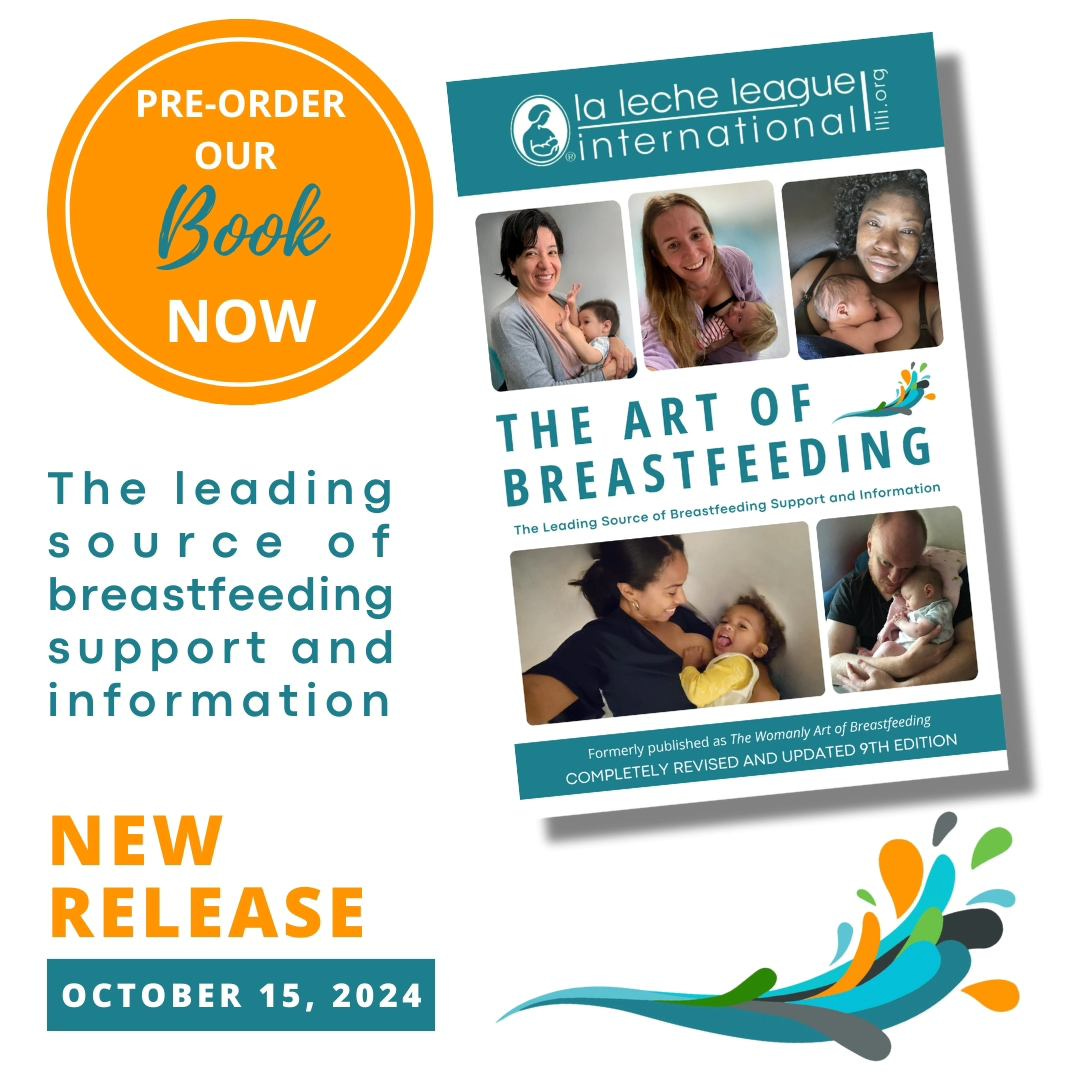The Art of Breastfeeding - Part One
Where we are supposed to believe that LLLI “isn’t about eliminating or erasing mothers or women”

After much fanfare and internal struggles, the (so-called) 9th edition of The [Womanly] Art of Breastfeeding (WAB) has just been released by La Leche League International. Except of course that it’s not the 9th edition of anything, at least according to a few of the most captured by the unicorns of gender woo higher ups in LLLI anyway.
A very loud faction of the movers and shakers in LLL who deny the sexed based realities of birth and breastfeeding felt that the previous edition of the WAB, which was published in 2010 was seriously out of date because it was not “inclusive” so that really the only way forward was to ditch this dinosaur and start afresh. I mean, there’s not even an entry for “transgender” in the 2010 index! No references to “chestfeeding” nor “bodyfeeding” or even surrogacy! Life has thankfully moved on from these cisheteronormative days and so should we!
What a pity that those pesky babies just refuse to get with the program. They continue to look for the breasts of their mothers once born and get upset if they can’t find them (because breasts have been purposefully removed or the baby is handed over to the purchasing parents), but fetal education is proving to be more difficult than compelled speech in adults.
Overall, I’d say that those who wanted a new book failed in their ambitions as this volume pretty much follows the previous editions that preceded it, with a table of contents that is very similar. Starting with before birth, the information meanders onwards in age stages to starting solids, weaning and beyond, followed by chapters on pumping and storing milk and special situations (such as premature babies, Down’s syndrome, etc.).
There was a discussion about the purpose of this book prior to it being written. What is its purpose? Is it meant to be a handy how-to guide for new mothers? Or a training manual for future Leaders? These two things are not the same.
Unfortunately, it is pretty obvious that both aims were attempted because this is one huge door stopper of a book. At 645+ pages long, any women wanting to learn about breastfeeding better study up while still pregnant because this is in no way a one-handed book that can be read by a mother who is breastfeeding her baby. If this book fell on your baby’s head, some serious damage would follow. And it will exclude anyone from leadership who is not a confident reader in English because it looks so intimidating size wise. To be told, “read this and then we can chat” may end the leadership potential of some women who might otherwise have become Leaders.
“Womanly” was the first discard
Of course, if your aim is gender neutral parenting, (even if you are a group founded to assist breastfeeding women), the first word to hit the exit is going to be that hurtfully gendered word that refers to an attribute formerly held only by natal women. Even though a primary aim of some men is to appear as womanly as possible, when applied to real women, it just can’t be tolerated.
During the run up to this book, a Leader survey was held about the title. Roughly one third of the respondents voted to retain “womanly” in the title, another third wanted this word ditched and the last third either didn’t know or didn’t care either way. So of course, the LLLI Board announced that the overwhelming vote had gone against “womanly” and moved on from there. Decisions from the LLLI Board are made by a simple majority, so the woke majority never have to front up and justify their decisions or explain that the Board decisions were not unanimous.
On page xv of the Introduction it says, “Womanly was an off-putting old-fashioned word for many younger readers”. No real argument there and plenty of leeway to think otherwise, but then veering off the path of reality, it follows this up with this observation, “The vast majority of those giving birth and breastfeeding will of course be women and mothers…”. Now if it had said ‘the vast majority of those who give birth and breastfeed are proud to be called women and mothers…’ I could have accepted this, but that’s not what they mean.
The oh, so subtle influence of gender ideology is woven like a spider’s web all through this book, just waiting to capture the unwary reader.
"The milk from the person who gave birth to her”
This is the answer to the question “what’s the best milk for babies”. In the previous edition, this question is missing. Presumably because life defined by one’s “identity” wasn’t assumed in those ancient days of 2010. The 2010 edition was written with an underlying understanding that (with the exception of a few women breastfeeding adopted babies) every woman reading this book was a woman who had given birth and called herself a mother.
One section that was in the previous edition but is missing from the new volume is something called “The Three Keeps”. These are “keep your milk flowing”, “keep your baby fed” and “keep your baby close”. These tips are there to ensure that women begin breastfeeding right at the start following birth, to help ensure a long-term supply. Interference for any reason at all in the establishment of early breastfeeding nearly always undermines achievement of the WHO recommendation of six months of exclusive breastfeeding.
In a previous post I discussed dads breastfeeding, and additionally, there are now many lactophilic men who view it as their right to have babies suckling on their nipples.
And here I examine some of the results of LLLI pretending that “everyone” has the right to “human milk feed” a baby.
Actually, the right to breastfeed is not vested in adults at all; this human right is one that is owned by babies. Breastfeeding is designed by purpose to serve the welfare and interests of babies, not their parents and certainly not some other adult. The fact that breastfeeding optimizes the health of birth mothers is no more than a bonus for us.
Both editions have a chapter called “Birth” (perhaps because without birth, there is no need for breastfeeding). They are similar in length (the 2024 edition chapter is nine pages longer than the 2010 edition).
A quick word count tells a compelling story: in the 2024 chapter where the “leading lady” is ALWAYS an adult human female the word “women” appears one time (and this is in relation to what obstetrician/gynecologists do) and the word “parents” also makes one appearance (in a paragraph about PTSD following birth). The word “mother” is totally absent. No mothers are created by giving birth in 2024.
In contrast, the chapter in 2010 mentions “mothers” 22 times and “women” six times. The only “parents” are those supporting their birth giving partners.
The LLLI Board edict about “using a variety of terms” in place of women and mothers has clearly been adhered to by the authors of the new edition.
Virtual is not the same as real
The introduction to the 2010 edition begins by saying:
Welcome to the newest edition of “The Womanly Art of Breastfeeding”! This is a book for you, wherever you are in your breastfeeding journey. It’s a book about developing a breastfeeding relationship with your baby, with strategies that help combine breastfeeding with your already busy life, and ideas for meeting any challenges along the way. There’s some science for sure, but we hope to bring to life the “art” part, the fun part, the way that you and your baby figure out your own dance and make this work for you.
In contrast, this latest edition keeps it short and business like:
Welcome to the ninth edition of La Leche League’s “meeting in a book” --the world’s best selling guide to breastfeeding since it was first published in 1958.
Every Leader has learned thanks to the Covid pandemic, there are vital differences between the traditional LLL in person meetings and meetings held virtually over the internet via Zoom.
In person meetings allow a degree of personal interactions and ‘learning by osmosis’ that Zoom meetings can never replicate and science backs this up. A study, the results of which were published Oct. 25 in the journal Imaging Neuroscience found:
“that the social systems of the human brain are more active during real live in-person encounters than on Zoom,” said Hirsch, the Elizabeth Mears and House Jameson Professor of Psychiatry, professor of comparative medicine and neuroscience, and senior author of the study.
“Zoom appears to be an impoverished social communication system relative to in-person conditions.”
And the new edition of LLL’s flagship book appears to be an impoverished version of the traditional The Womanly Art of Breastfeeding. You can’t remove women and mothers from breastfeeding and maintain the sort of relationship that babies are expecting and needing in order to thrive as new human beings.
Part Two of my critique of The Art of Breastfeeding will focus on the possible legal perils that Leaders could face if they live in countries with anti-LGBTQ legislation.




I wouldn’t have been able to breastfeed my babies without the support of other women.
"The milk from the person who gave birth to her” So they even use she/her for a hypothetical random baby—of indeterminate sex—but they can't call Mothers Mothers?
That can't be a coincidence.